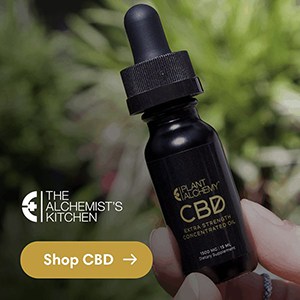News outlets can’t afford to ignore it. Everybody’s heard of it, but nobody really knows what it is. It’s CBD, and, for that matter, a host of other constituents of the cannabis plant making big waves in headlines and on shelves, such as CBG.
The mystery surrounding this ubiquitous cannabinoid, second in fame only to THC, isn’t just a consumer issue—scientists are also pretty much in the dark. Recently, The Atlantic described CBD’s ascendance with the only metric we can all understand: at its zenith, CBD received three times more Google queries than Beyoncé.
While experiential evidence of cannabis’s potency as a spiritual, medical, or recreational agent goes back a dozen millennia, scientific research that parses how it does what it does, and attempts to predict those effects, is still in its infancy. It’s hard to know exactly how all the moving parts—chemicals and receptors, intrinsic or exogenic—interact with each other, so making medicine that can reliably flip one switch or another is tough to do.
That said, beginning-stage research isn’t the same as no research at all, and while time is going to play a big factor here (among other things, long-term impacts have to be monitored, well, long-term), there are some compelling reasons—academic and anecdotal—to add cannabis derivatives to your home apothecary.
So, since you can’t swing a patchwork bong bag without hitting some new product infused with the stuff, here’s a quick rundown of what we do know about CBD, and why its lesser-known siblings, like CBG, are worth experimenting with, to see how their medicinal potential measures up to the hype.
The Endocannabinoid System
You already know we have systems that regulate our breathing (respiratory system) and blood flow (circulatory system). We also have something called the endocannabinoid system. Discovered in conjunction with cannabis research in the early 1980s (hence the name), it’s comprised of chemicals and receptors running throughout the body, and plays a role in regulating mood, memory, appetite, and pain.
The compounds that bind to this system (and sometimes, outside of it, see below) are called cannabinoids, and of those that occur naturally, we can make them ourselves (endocannabinoids) or get them from plants (phtyocannabinoids). In addition to cannabis, plants like black pepper, echinacea, and cacao all produce cannabinoids. Of those made or catalyzed by the cannabis plant, some are psychoactive, like THC, while others are not, and include compounds ranging from the ubiquitous CBD to up-and-comers like CBG.
CBD: What We Know So Far
- It’s the most common cannabinoid in hemp, and the second most common (behind THC) in cannabis.
- Eat too much of that edible? CBD can mitigate the impact of THC, but caveat emptor: the ability of CBD to lessen a THC high depends on how much you take and when you take it, meaning that CBD can either exacerbate or diminish the felt effects of THC. Plan accordingly.
- It’s also a potent anti-inflammatory, making it a suitable remedy for myriad conditions, and even a homeostatic aid. It can be ingested or applied topically to control skin conditions like eczema and psoriasis, and joint conditions like arthritis.
- A brief rundown of applications for CBD, outlined in more detail and with supportive evidence, can be found in Cannabis Pharmacy: The Practical Guide to Medical Marijuana (a popular resource in the community, intended for physicians and laypeople alike). These include:
-
-
-
- Treatment of insomnia and anxiety symptoms.
- An anticonvulsant and antispasmodic, it’s a popular choice for mitigating symptoms of Parkinson’s, multiple sclerosis, and seizure disorders.
- Treatment of autism spectrum symptoms (especially agitation).
- Decreases register of pain; used to treat fibromyalgia and even post-surgical pain.
-
-
- Not considered psychoactive, CBD can nonetheless induce an upbeat, floaty feeling. It’s subtler than THC, and you need to consume it in higher doses to get loopy or tired. If you take it recreationally and your natural state is already of the go-with-the-flow/go-for-a-snack variety, you might not even notice it.
Legality
If a product has less than 0.3% THC it’s considered federally legal to produce (except in Idaho, Mississippi, New Hampshire, and South Dakota) and to ship interstate (even industrial hemp isn’t completely THC-free). More on the relationship between THC and CBD a little later.
Don’t Sleep on CBG
Another cannabinoid you may not have heard of but will likely soon see everywhere is CBG. Here’s the deal:
- Also non-psychoactive and analgesic.
- It’s the parent cannabinoid, or precursor, to THC and CBD, and in adulthood, it’s more common in hemp than cannabis plants.
- How it’s unique: Remember how there’s a series of receptors called the endocannabinoid system? CBG interacts with receptors both within and outside that system.
- Cannabis Pharmacy lists the following applications, supported by cited studies (Leafly also has a good rundown):
-
-
-
- Used to treat symptoms of Inflammatory Bowel Disease (IBD)
- Antiseptic and antibiotic (without annihilating your biome), shown to be effective even against stubborn strains of staph, such as MRSA.
- Has demonstrated anti-tumor properties, especially for prostate and oral cancers.
- CBG has also been shown to decrease intraocular pressure (fluid inside the eye), Glaucoma and Graves’ Opthalmopathy (it me) patients rejoice.
-
-
Synergy
There are different schools of thought on whether CBD can be effective without a little help from THC—not necessarily so much THC that you’d feel it, just enough to help CBD do its job. Part of the reason for the debate is that the science is so new, but it’s also worth noting that everybody’s endocannabinoid system is different. You may find that you like a 20:1 ratio of CBD to THC (considered a high CBD, low THC ratio), or that you prefer CBD (or THC) on its own. Maybe you like them in equal amounts (look for 1:1 ratios). There’s no way to know what will work for you until you give it the ol’ college try. So to speak.
CBD and CBG don’t seem to have the same synergistic effects as CBD and THC, but it’s too soon to tell what the chemistry will show. Right now, second only to sourcing clean medicine, experimentation is key. This sounds like leftist lip service, but it’s not: everybody truly is different, and will process and feel the impacts of cannabis derivatives differently. Trial and error is your friend.
Check out CBD offerings from The Alchemist’s Kitchen here!







